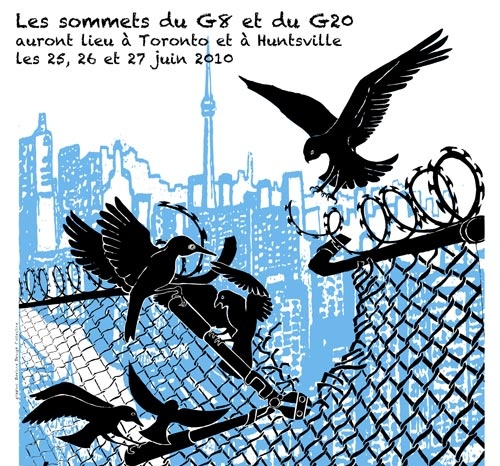 |
 |
 |
 |
 |
 |
|
 |
 |
 |
 |
 |
 |
 |
Régions du Québec |  |
 |
 |
|
 |
 |
|
 |
 |
|
 |
 |
 |
 |
 |
 |
Rubriques (sujets) |  |
 |
 |
|
 |
 |
|
 |
|
 |
 |
 |
RECORDING TUPAJ KATARI'S DEATH
Tupaj Katari was an important leader of the Aboriginal rebellion against the Spaniards in the now-called Bolivia. Today marks the 221 th anniversary of his salvage quartering by the Royalist Troops. By his courrage and determination he has inspired generation of Bolivian Aboriginals fighting against a flagrant systemic injustice
(Painting by Walter Solon http://www.funsolon.org/SOLON/OBRA/indiceobra )
TUPAJ KATARI (1750-1781)
221 years after the execution of our Aymara Chief
by Ivan Ignacio*
Abya-Yala Marka, 13/11/2002 - Tupaj Katari, name adopted by Julian Apaza in memory of the dauntless Tupaj Amaru (José Gabriel Condorkanqui) and the fearless Tomás Katari, has been one of our greatest martyrs in the Aymara people’s history, an indomitable leader and a great military strategist for the Andean Aboriginal army; he has been the uncontested chief of the aboriginal rebellion during the sieges of La Paz.
He was born in 1750 in the Sicasica community, an important agricultural center, at 4000 meters above sea level. Married to Aymara chief Bartolina Sisa, he shared Tupaj Amaru’s plans of liberation and emancipation of our aboriginal peoples, keeping constant constact for many years with the « Lord of Tungasuca ».
Despite some tactical conflicts regarding the future siege and taking of La Paz with Tupaj Amaru’s family, Tupaj Katari will initiate the first siege which will last for 109 days, in March of 1871, with 40 000 men at his side. He will undertake a second siege for 64 days. Consequently to these two events the Spanish army, composed of Spaniards, Creoles and Metis, will lose 10 000 of its 23 000 men.
A fresh supply of troops provided to the Spanish army will give them an opportunity to break the siege in July 1st 1781; and it is without much human loss that Tupaj Katari’s army will retreat. Nevertheless, the hostilities will not stop, taking the form of permanent guerrillas, and in the beginning of August , this time supported José Gabriel’s brother Andrés Tupaj Amaru, another siege will be imposed to the city of La Paz. Andrés’ plan was to flood the city using an intricate hydrolic installation on Choqueyapu river. But another arrival of new supplies to General Reseguín’s troops will cause our allies’ defeat on October 17th , in the municipality of El Alto.
Tupaj Katari was planifying another attack and gathering a new army on the borders of Lake Titikaka when he’s been the victim of his collaborator Tomás Inca Lipe’s perfidious treason. Unscrupulous, Lipe will lead his chief directly into the royalist troop’s hands in the locality of Chinchaya. Prisoneer of the Spaniards, our brother will share the same atrocious destiny that his predecessor Tupaj Amaru .
On November 13th of 1781, the Chief Tupaj Katari will be sentenced to death, his body to be quartered on the public place in the aboriginal community of Peñas (Q’arq’a Marka) also known as Nuestra Señora de las Peñas, situated in the altiplanic region of the actual Republic of Bolivia. Some chronicles report that the execution took place on the same day, others claim it was effective two days later, on November 15th of 1781.
«... A mi solo me matarán, pero mañana volveré y seremos millones **» will claim Tupaj Katari to his oppressors at the moment of his dramatic capture. He will pass the last moments preceding his execution circled by representents of the colonial oppression : the parish, the military delegate, the municipal officer, the « notable » Creoles, and its corrupted guardians, all symbolising the european mediocrity that came for the destruction of the life and harmony of our institutions and our social, economical, political, spiritual and cultural ways of organizing.
Tupaj Katari’s sentence will be executed, but before he’ll have to endure abominable tortures. After cutting his long hair, a symbol of the Aymara chief’s rebellion and energy, his tongue will be taken off alive, so to demonstrate the Spaniards’ intention to shut off his voice and his message of rebellion. Then they proceeded to the execution, quartering Tupaj Katari with the force of 4 horses tied to his legs and arms.
The order had been given, and a powerful, disturbing and atrocious shout echoed way throuth the mythical Andes, breaking the silence that has installed itself up to the fatidic moment, up to this moment when 4 horses tore up in pieces Julian Apaza, Aymara Warrior Chief, to the 4 horizons. The multitude’s muted shout of indignation will answer his voice.
As Tupaj Amaru’s, Tupaj Katari’s body, dimembered and cutted into pieces, will be exposed and travelled in all the territory of Qullasuyu, in a way to « scare the Indian Rebels ». His head will be exposed on K’ili K’ili Peak, (La Paz); his right arm in Ayo Ayo, his left in Achacacho; his right leg in Chulumani, his left in Caquiaviri.
On September 5th of 1782, his wife Bartolina Sisa will be executed by the same oppressors that had killed him , her supplice including horrid details of torture. The same destiny will be reserved to Tupaj Katari’s sister, Gregoria Apaza; in 1783, Tupaj Katari’s and Bartolina Sisa’s ten years old son will be kidnapped and never again seen.
Never there had been such colonial horror as the spilling of so much hatred on our Land. Never there had been massacres and murders as bloody and shameless as those commited against our peoples and its populations, never had existed so much barbarism and brutality against the Andean Native communities than in these deadly ages.
VICTORIOUS FOR THOUSANDS OF YEARS !!!
JALLALLA JILATA TUPAJ KATARI !!!!
Note from the author : Special thanks to CSUTCB’s and CANO ’s websites1
*Ivan Ignacio is President of CANO-Toronto and National Coordinator in Canada
**** « They will kill me alone, but tomorrow I’ll be back and we will be millions ! »
| Documents inclus | Taille |
|---|---|
| 9871.jpg | 0 octets |
 |
 |
 |
 |
Dossier G20 |  |
 |
 |
|
 |
 |
|
 |
Nous vous offrons plusieurs reportages indépendants et témoignages...

Liste des activités lors de ce « contre-sommet » à Toronto Vous pouvez aussi visiter ces médias alternatifs anglophones... Centre des médias Alternatifs Toronto 2010.mediacoop.net Media Co-op Toronto http://toronto.mediacoop.ca Toronto Community Mobilization www.attacktheroots.net (en Anglais) |
 |
 |
 |
 |
 |
 |
 |
CMAQ: Vie associative |  |
 |
 |
|
 |
 |
|
 |
 Collectif à Québec: n'existe plus. Impliquez-vous ! |
 |
 |
 |
 |
 |
 |
 |
 |
|
 |
 |
 |
Ceci est un média alternatif de publication ouverte. Le collectif CMAQ, qui gère la validation des contributions sur le Indymedia-Québec, n'endosse aucunement les propos et ne juge pas de la véracité des informations. Ce sont les commentaires des Internautes, comme vous, qui servent à évaluer la qualité de l'information. Nous avons néanmoins une
Politique éditoriale
, qui essentiellement demande que les contributions portent sur une question d'émancipation et ne proviennent pas de médias commerciaux.
This is an alternative media using open publishing. The CMAQ collective, who validates the posts submitted on the Indymedia-Quebec, does not endorse in any way the opinions and statements and does not judge if the information is correct or true. The quality of the information is evaluated by the comments from Internet surfers, like yourself. We nonetheless have an
Editorial Policy
, which essentially requires that posts be related to questions of emancipation and does not come from a commercial media.


